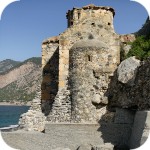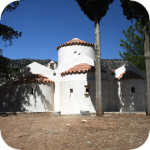

There are places in Crete that we call magical. They are usually distinguished by a specific history or location in remote corners of the island. One such place is the over 1000-year-old Byzantine church of Agios Pavlos, erected on the remote Selouda beach in the south of Crete.

Redirected from the page - Church with the Golden Step. The Church of the Blessed Virgin Mary with the Golden Step dating from the seventeenth century is the westernmost sacred building of this type, 9 kilometers away from Elafonissi. There is no way to overlook the convent leading to this monastery, because Hrisoskalitissas is about half a kilometer from the main road leading from Kissamos towards Elafonisi. It is worth joining this church with a rest on the most famous beach of Crete. The main advantage of Hrisoskalitissas, for which it is worth seeing it is a beautiful location on the top of a rock rising steeply over the sea shore.

The Church of the Blessed Virgin Mary with the Golden Step dating from the seventeenth century is the westernmost sacred building of this type, 9 kilometers away from Elafonissi. There is no way to overlook the convent leading to this monastery, because Hrisoskalitissas is about half a kilometer from the main road leading from Kissamos towards Elafonisi. It is worth joining this church with a rest on the most famous beach of Crete. The main advantage of Hrisoskalitissas, for which it is worth seeing it is a beautiful location on the top of a rock rising steeply over the sea shore.

Among the olive groves in the place called Logari, which is less than a kilometer from the village of Kritsa, there is a small Byzantine church of Panagia Kera from the 13th-14th centuries. It is probably one of the most famous sacred monuments in Crete. Of the hundreds of other similar churches, Panagia Kera is distinguished by rich polychromes decorating the entire interior. An interesting fact is that the Byzantine frescoes, which can now be admired, have been hidden under plaster for hundreds of years. Former Christians hid their presence to protect them from destruction by the Turkish occupant. Frescos were rediscovered only in 1971.